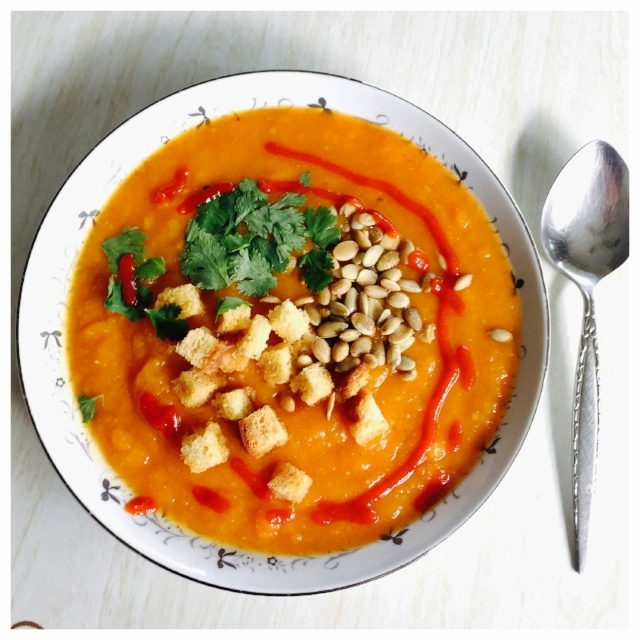Red Curry-Miso Pumpkin Soup
If you need a little something different for your Thanksgiving spread, you can try this red curry-miso pumpkin soup. I know red curry and miso don’t exactly conjure-up the traditional flavors of the holiday but that’s all the more reason to try this recipe, especially if you’ll be appearing at assorted Friendsgiving events. The pumpkin keeps it “on theme” while dodging any chance at “more of the same”. And miso and red curry paste both pair well with squash. Why not shoot for “progressively” traditional this year as a way to build bridges at your Thanksgiving table?
Ingredients:
- 1 chopped yellow onion
- 1 cup chopped carrots
- 2 tbsp Thai Red Curry Paste
- 4 cups broth
- 1 peeled and chopped sweet potato
- 1/2 a small roasted sugar pumpkin (a can of pumpkin puree is fine as a substituation for fresh pumpkin)
- 2 cups water (or enough to thin to desired consistancy)
- a wedge of lime
- 1 tbsp miso paste
- cilantro, croutons, and pepitas for garnish
- sriracha (optional)
Directions:
- In a large pot, saute the onion and carrots together for a few minutes until the onion starts to soften.
- Add the Thai Red Curry Paste and mix to combine.
- Slowly add the broth, deglazing the bottom of the pot in the process.
- Stir in the sweet potato and pumpkin and bring the temperature up to a soft boil. (Add water if necessary to cover the ingredients.)
- Let cook until the sweet potatoes are soft and cooked all the way through.
- Carefully blend the soup with an immersion blender. (Using a standard blender is fine, just do it in batches and let the soup cool some first as the heat can cause damage.)
- Squeeze a wedge of lime and stir it in for taste.
- Add water if necessary to thin the soup to your desired consistancy.
- Return to tempurature and then remove from heat before adding the miso paste. (Miso paste is temperature sensitive. Do not boil.)
- Remove a cup or so of soup and disolve the miso paste in it, then return it the pot and stir to combine.
- Serve immediately in bowls and garnish with cilantro, croutons, pepitas and sriracha if using.
And now for the disclosure statement…
If you know me or have been following here for a while then you know I’m not one for accuracy or measurements when it comes to cooking. I’m about flavor! I’m intentionally working to better document my recipes as I know that they can be helpful to others. However, a recipe can often feel restricting, stunting the creative process when one assumes they don’t have all the necessary ingredients to make a dish. Dismiss that hesitation and lean-in. If you look at recipes and consider them as flavor profiles instead of how-to guides, you’ll discover your inner chef. The recipe above is actually inspired by this dish from Heidi Swanson’s cookbook Super Natural Every Day. It looks quite a bit different, but it’s kinda the same. I substituted sweet potatoes for the new potatoes which then prompted a switch from lemon juice to lime juice. I skipped the tofu and kale all together but for the most part, the ingredients are much the same. The big difference is the original recipe is like a salad, whereas mine is a soup!
Have I lost you yet? My point is cooking is all about flavor, and more importantly it’s understanding flavor profiles! Flavor combinations are the bones to every good meal and if you are unsure of where to begin, I strongly recommend this book. (There is also a vegetarian version if that’s more your things and I will tell you that I own both and use them constantly!)
Once you understand which foods and flavors work well together, you can begin to craft original recipes. In my opinion, this is what takes your from being a cook to becoming a chef. Techniques can be taught but melding flavors together is an art. Much like a painter that combines colors to create new colors, a flavor profile is derived from depth. It’s one thing building on another to produce taste which helps define your palate. If you let the seasonal produce be your guide and flavor combinations develop your palate, you’ll discover new ways to assemble meals, even in a pinch!
Good luck, get creative, and enjoy the craft of cooking!
How to Feed a Senior is a participant in the Amazon Services LLC Associates Program, which is an affiliate advertising program. If you choose to purchase items after clicking on these links, I will earn a small commission at no extra cost to you.





